





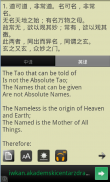


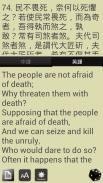
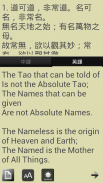
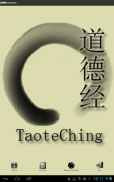



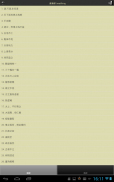
TaoteChing Chinese & English

TaoteChing Chinese & English açıklaması
The Tao Te Ching original text with translation by modern Chinese and English translation.
The Tao Te Ching, Daodejing or Dao De Jing (道德經: 道 dào "way"; 德 dé "virtue"; 經 jīng "classic" or "text"), also simply referred to as the Laozi, is a Chinese classic text. According to tradition, it was written around 6th century BC by the sage Laozi (or Lao Tzu, "Old Master"), a record-keeper at the Zhou dynasty court, by whose name the text is known in China. The text's true authorship and date of composition or compilation are still debated,[3] although the oldest excavated text dates back to the late 4th century BC.
The text is fundamental to both philosophical and religious Taoism (Daojia, Chinese: 道家, Pinyin: Dàojiā; Daojiao, Chinese: 道教, Pinyin: Dàojiào) and strongly influenced other schools, such as Legalism, Confucianism and Chinese Buddhism, which when first introduced into China was largely interpreted through the use of Daoist words and concepts. Many Chinese artists, including poets, painters, calligraphers, and even gardeners have used the Daodejing as a source of inspiration. Its influence has also spread widely outside East Asia, and is amongst the most translated works in world literature.
The Wade–Giles romanization "Tao Te Ching" dates back to early English transliterations in the late 19th century; its influence can be seen in words and phrases that have become well-established in English. "Daodejing" is the pinyin romanization.
Modern Çince ve İngilizce çeviri çeviri ile Tao Te Ching orijinal metni.
Tao Te Ching, Daodejing veya Dao De Jing (道德 经: 道 DAO "yol"; 德 dé "erdem"; 经 "klasik" veya "metin" Jing), aynı zamanda sadece Laozi olarak adlandırılan, bir Çin klasik metin . Geleneğe göre, bu ismi metin Çin'de bilinen tarafından, ("Eski Usta" ya da Lao Tzu), Zhou hanedanı mahkemede bir rekor kaleci adaçayı Laozi tarafından 6. yüzyılda M.Ö. yazılmıştır. En eski kazı metin geç M.Ö. 4. yy kadar uzanır rağmen kompozisyon ya da derleme metin gerçek yazarlık ve tarih hala, [3] tartışılmaktadır.
Metin felsefi ve dini hem Taoizm esastır (Daojia, Çin: 道家, Pinyin: Daojia; Daojiao, Çin: 道教, Pinyin: Daojiao) ve bu Legalism gibi güçlü etkisi diğer okullar, ilk Konfüçyüsçülük ve Çin Budizm, tanıttı hangi Çin'e büyük ölçüde Taocu kelime ve kavramlar aracılığıyla yorumlandı. Şairler, ressamlar, hattatlar, ve hatta bahçıvanlar dahil olmak üzere birçok Çinli sanatçılar, ilham kaynağı olarak Daodejing kullandık. Onun etkisi de Doğu Asya dışında yaygın, ve dünya edebiyatının en tercüme eserler arasındadır etti.
Wade-Giles Romalılaşmanın "Tao Te Ching" 19. yüzyılın başlarında İngiliz dönüştürebilir kadar uzanır; etkisini kelime ve İngilizce köklü haline gelmiştir ifadeler görülebilir. "Daodejing" pinyin Romalılaşmanın olduğunu.

























